When it comes to process control, the Thermo Scientific™ ARLTM 9900 IntelliPower™ series X-Ray spectrometers are the most powerful and adaptable on the market.
Its proprietary technology, which combines X-Ray diffraction (XRD) and fluorescence (XRF) into one unit, is the secret of its adaptability and productivity. The ARL 9900 enables the rapid and precise examination of numerous solid samples.
Every minute, a fresh sample can be loaded for analysis in a simultaneous setup. The goniometer can detect up to 86 elements (B to Am, or 5 to 95 in the Mendeleev table) in concentrations ranging from ppm to 100%.
Sturdy integrated software makes it easier to commission new operations quickly and to report and archive analytical data in the most optimal places on time.
The versatile design and extensive selection of options of the ARL 9900 IntelliPower series enable it to be tailored to fulfill any specific process control requirement. The majority of industrial settings can simply fulfill the requirements for simple installation.
The ARL 9900 has a high level of automation and digital control, making it very easy to use. It can be configured to perform continuous process monitoring in an unattended mode with a direct connection to automatic sample preparation machines if it has the necessary automatic sample introduction equipment.
Furthermore, Thermo Fisher Scientific’s global after-sales assistance is included automatically.
The ARL 9900 IntelliPower Series in Summary
Every Analytical Requirement Met
- Determining the appropriate generator power for the application. From 1500 to 4200 W
- IntelliPower technology can generate up to 2500 W without requiring external water cooling
- Combining two X-Ray technologies into a single instrument offers simplicity, versatility, and productivity
- Identifies and assesses up to 86 components, ranging from ppm to 100%, depending on the setup
- The instrument’s modular construction enables modification to meet specific application needs
- The sequential and fixed channel WDXRF capabilities, including quantitative XRD analysis, can suit all analytical requirements
- An easy and reliable method for introducing samples
- Easy to adjust to changing analytical needs
- Connecting to automated sample preparation equipment enables online process control
- The instruments are the successors to the successful ARL 9800 series
ARL 9900 IntelliPower Applications
A Wide Range
The ARL 9900 series is ideal for enterprises that require quick process monitoring to ensure quality control. Among them are those who manufacture or process:
- Metals: iron, steel, aluminum, copper, and their alloys, titanium, magnesium, tin, zinc, slags, sinters
- Refractories and others
- Mining: ores, minerals, limestone, beach sands
- Cement
- By-products
ARL 9900 IntelliPower Versatility
High-Performance in Every Application
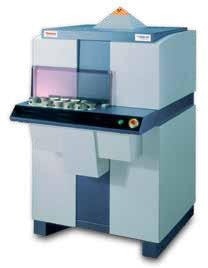
Image Credit: Thermo Fisher Scientific - Elemental and Phase Analysis
There are many different components that the ARL 9900 can identify. Because of its modular construction, the instrument can be precisely customized to fit the needs of any unique application. The instrument has the following settings:
- Up to 32 fixed monochromators available for rapid inspection
- Three goniometers can be set up for either quantitative and standard-less analysis of a single element or qualitative and semi-quantitative analysis, which involves scanning the X-Ray spectrum to find elements in a sample
- The purpose of the small, integrated X-Ray diffraction apparatus is process control phase analysis
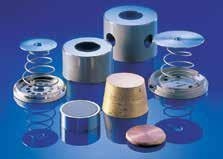
Small and large cassettes can accommodate samples of various sizes. Image Credit: Thermo Fisher Scientific - Elemental and Phase Analysis
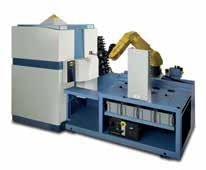
Full automation through ARL SMS-2500. Image Credit: Thermo Fisher Scientific - Elemental and Phase Analysis
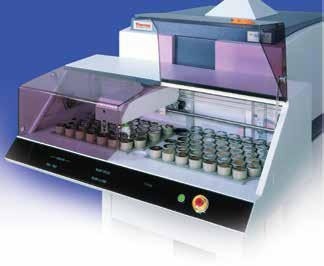
Large X-Y sample changer. Image Credit: Thermo Fisher Scientific - Elemental and Phase Analysis
ARL 9900 IntelliPower Technical Features
X-Ray System
Designed with efficiency and dependability in mind:
- An optical system that is very sensitive continuously analyzes data and measures data with extreme precision
- An X-Ray tube is placed above the sample to shield it and the instrument from damage caused by faulty samples, such as metal drill bits or fragile pellets.
- Well-designed construction ensures maximum dependability and lifespan in use.
- All elements’ detection limits drop and sensitivity rises as the X-Ray tube approaches the sample. Effective full-spectrum stimulation is produced by the Rh anode, but the most abundant elements are not affected significantly. Excellent radiation transmission efficiency during light element activation is made possible by a very small Be window (50 microns). LoVap technology eliminates the need for any W coating on the interior face of the window ensuring exceptional long-term analytical stability
- The vacuum chamber used for the analyses has a single lid. There are thus fewer vacuum seals and a lower chance of leaks.
- Well-managed temperature and vacuum pressure offer superior short- and long-term stability.
Power Supply: A Choice to Suit Any Applications
Instruments from the ARL 9900 Series can be chosen with an integrated high-frequency, medium- or high-power solid-state generator to best fit each application.
- Installing an additional water chiller is not required as the 1500 W or 2500 W power supply each includes a separate cooling circuit.
- A 4200 W power supply for applications requiring low detection limits and great performance. At its highest, the conventional generator can generate up to 60 kV/70 mA or 35 kV/120 mA
Sample Introduction: Several Degrees of Automation
- The sample introduction mechanism is fast, simple to operate, and incredibly reliable, thanks to its 12-position sample changer
- The large X-Y magazine can automatically handle multiple samples. There are 98 coded positions for samples in cassettes or on designated supports in the X-Y magazine. Coding every site enables independent functioning and reduces the time needed to identify which samples are relevant to a particular study. If needed, this larger magazine can easily take the place of the traditional 12-position arrangement
- Pressed powders in steel rings can be connected to transport belts using an X-Y sample changer. This fundamental automation is known as ARL SMS-XY
- For a variety of sample types, the optional ARL SMS-2300, SMS-2500, and SMS-3500 robotic systems provide completely automated sample introduction and preparation
- The device can automatically perform unattended continuous process monitoring and sound an alert if any anomalies with the SMS settings are found. The entire sample preparation and analysis process is connected via the versatile and very strong ARL SMS-2300 and SMS2500 devices. The most recent automation innovation is the ARL SMS-3500 series, which uses a larger, quicker robot to service an XRF instrument in addition to an OES
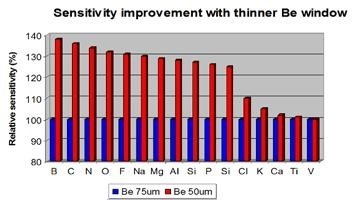
Image Credit: Thermo Fisher Scientific - Elemental and Phase Analysis
Full Microprocessor Control
Putting the Emphasis on Reliability and Ease of Use
With full digital control, the ARL 9900 is a simple device to operate. It also guarantees consistent outcomes from various procedures.
The microprocessor architecture consists of clusters of microprocessors, microcontrollers, and digital signal processors coupled via full duplex links. They oversee the instrument's functioning, manage the integrated diffraction system, monochromators, and goniometers, and routinely verify hundreds of status points.
The OXSAS analysis program sends instructions to the master microprocessor, transferring them to the appropriate cluster. The results of the analysis are shown on the screen.
Fixed Monochromators
High-Speed Simultaneous Analysis
Due to its exclusive focus on identifying and assessing a single element, fixed channels provide excellent sensitivity, quick processing, and quick analysis. ARL 9900 series monochromators can be examined simultaneously by up to 32 or 24 of them if a goniometer is incorporated.
The compact slit-crystal form optimizes the sensitivity and spectral background levels, making it possible to identify components at extremely low concentrations. The most recent detectors guarantee a far more accurate analysis and a wider linearity of response. Using detector gas in conjunction with any element from Na is not required.
Each monochromator is equipped with a mechanism that guarantees exceptional stability throughout the analysis, controlling temperature to within ± 0.1 C. Multilayer synthetic crystals are utilized to investigate the light elements. There are options in the software for deadtime correction, high voltage, and pulse height discrimination.
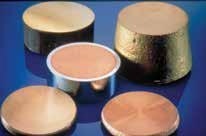
Image Credit: Thermo Fisher Scientific - Elemental and Phase Analysis
Goniometers
Very Precise Sequential Analysis
The goniometers can be set up to do qualitative analysis, such as scanning the X-Ray spectrum for components in a given sample, as well as quantitative analysis on individual elements. Two extremely quick and precise gearless goniometers for ARL 9900 series instruments provide standard-less, quantitative, and qualitative analysis.
The Thermo Scientific SmartGonio can analyze elements ranging from F to Am. This little goniometer combines two detectors and three crystals to provide a flexible and inexpensive detecting device. Three SmartGonios can fit within the gadget at once.
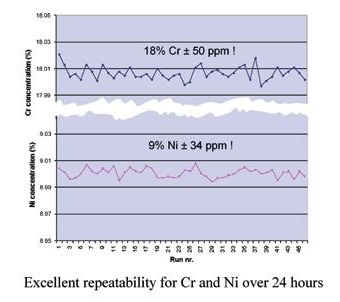
Excellent repeatability over 24 hours, here for Cr and Ni in steel. Image Credit: Thermo Fisher Scientific - Elemental and Phase Analysis
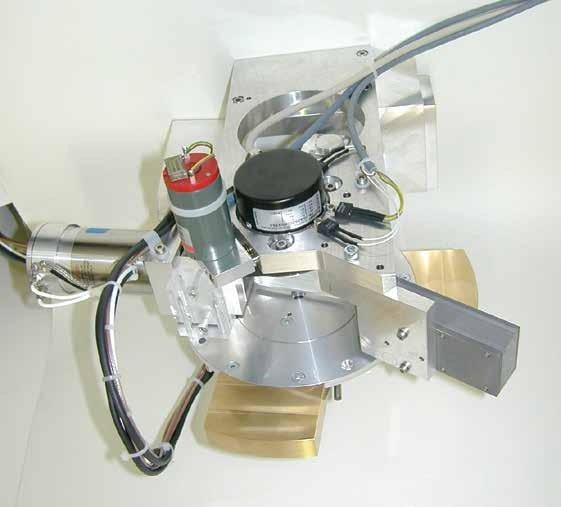
The compact SmartGonio covers F to Am. Image Credit: Thermo Fisher Scientific - Elemental and Phase Analysis
The F45 universal goniometer is an appropriate replacement in applications requiring extra crystals and collimators. Up to two universal goniometers can be installed.
Microprocessors utilizing moiré fringe technology enable both goniometers to position the crystal and detector quickly and precisely, producing extremely accurate sequential X-Ray spectroscopy. This design has several significant benefits.
- Fast positioning: Slewing at a maximum speed of 4800° 2 theta per minute is five times more quickly than a standard goniometer and up to twenty times faster than a scanner
- Theta/2theta angular link between crystal and detector automatically aligns. Unlike traditional systems, this alignment is done electronically by the microprocessor, so no mechanical modifications are required
- Rapid qualitative analysis- Continuous digital scanning allows for ultra-fast spectra collection speeds of up to 1200°/min. Peak identification occurs automatically
- These “no wear” systems maintain consistent angular repeatability (< ± 0.0002°) and precision (0.001°) due to the absence of friction-causing gears
- High accuracy of peak positions (e.g. 0.01° with LiF crystal)- The analytical peaks are positioned precisely where they should be in principle, offering up to 10 times higher performance than traditional systems
- Independent crystal and detector rotation enables the installation of two detectors side by side. Secondary collimators in front of detectors improve count rate and resolution
- The universal goniometer may accommodate up to nine different crystals for specific uses. This enables the analyst to select the optimal crystal for every X-Ray spectra segment. A maximum of four main collimators are available to enhance resolution or intensity (fine, medium, coarse, and extra coarse)
Both goniometers are fully capable of being used to research non-routine objects. Thermo Scientific™ QuantAS and UniQuant™ software packages allow standard-less analysis and backup for fixed channels.
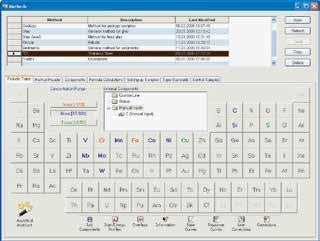
Analytical Assistant helps define analytical programs, calibrations and instrument use. Image Credit: Thermo Fisher Scientific - Elemental and Phase Analysis
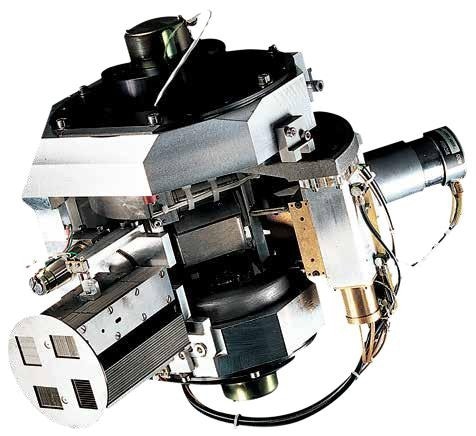
The 5th generation Moiré fringe universal goniometer. Image Credit: Thermo Fisher Scientific - Elemental and Phase Analysis
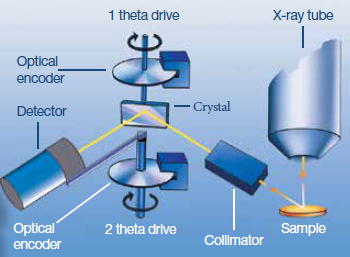
Goniometer principle of operation. Image Credit: Thermo Fisher Scientific - Elemental and Phase Analysis
- To provide angular positioning that guarantees the θ/2θ connection between the crystal and detector, Moiré fringe optical encoders are utilized:
- No wear
- No friction
- Exceptional precision in angular placement
- Crystal temperature regulation to achieve optimal analytical stability
Two Techniques Integrated in a Single Instrument
XRF and XRD Capability in One Instrument
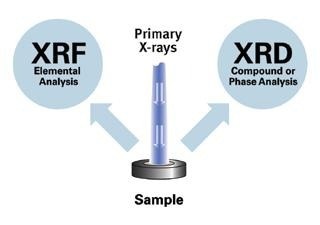
Integration of XRF and XRD in the same instrument: one sample, one instrument, one analysis for two techniques. Image Credit: Thermo Fisher Scientific - Elemental and Phase Analysis
The elemental makeup of a sample can be determined via X-Ray fluorescence (XRF) analysis, however, the method of mixing the elements cannot be revealed. The sole way to gather mineralogical information is by X-Ray diffraction.
For instance, a typical crystalline sample's entire calcium or iron content may be ascertained using XRF. The phases or compounds in crystalline materials, such as rocks, minerals, oxides, and products, can be examined using XRD.
Thus, XRD advances the analysis in the same sample by providing details on the contents of CaO, CaCO3, Ca(OH)2, and other Ca phases, as well as the levels of Fe phases, including FeO, Fe2 O3, Fe3 O4, Fe3 C, and other Fe phases. As a result, integrating the findings from both XRF and XRD methods enables a more thorough and accurate evaluation of each particular crystalline sample.
In the past, doing these kinds of studies needed two distinct kinds of X-Ray equipment, which meant regular upkeep and operation at a significant expense to the user. Nevertheless, the combination of both methods in a single ARL 9900 instrument is made possible by the integration of state-of-the-art X-Ray diffraction systems, offering the user several advantages such as:
- Only one sample introduction
- Single-user interface for both techniques
- Combined elemental and phase data into a single analysis bulletin
- Minimized floor space
- No water cooler at mid-power levels
Compact Integrated XRD Systems
Productive, Precise
The tiny integrated XRD equipment's Moiré fringe positioning system makes accurate qualitative and quantitative scans possible. Sample alignment issues are avoided by precise sample positioning and parallel beam X-Ray geometry.
Analytical sensitivity and repeatability are improved while working in a vacuum at a constant temperature, especially for fragile phases like free lime. Frequently reported use examples include:
- Iron phases in DRI (Direct Reduced Iron) processes
- Phases related to electrolysis of aluminum
- Other mineral and mining applications
- Amorphous content in GBFS and slag cement
- Free lime in clinker and in slags
- Clinker phases (C3S, C2S, C3A andC4AF) for which the ClinkerQuant calibration is available
- Fe2+ determination in sinters
One particular version of the small Integrated XRD system is referred to as the Free Lime-Quartz-Limestone Channel. Free lime determination in clinker and slags, limestone additions in cement, hot meal calcination monitoring, and quartz content in raw meals are still possible, but at a reduced cost.
Automated Options
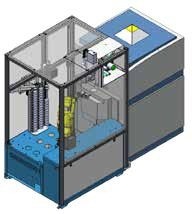
Full automation through ARL SMS-2300. Image Credit: Thermo Fisher Scientific - Elemental and Phase Analysis
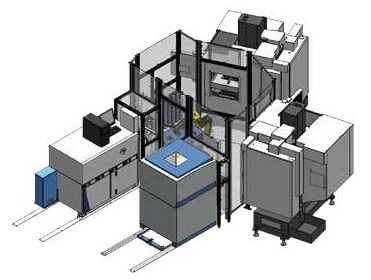
Full automation through ARL SMS-3500 linking ARL iSpark and ARL 9900. Image Credit: Thermo Fisher Scientific - Elemental and Phase Analysis
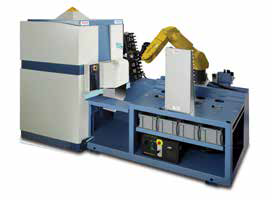
Full automation through ARL SMS-2500. Image Credit: Thermo Fisher Scientific - Elemental and Phase Analysis
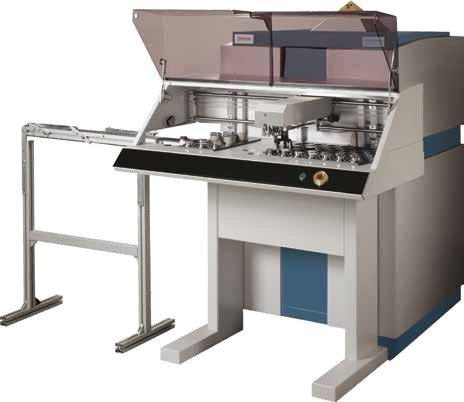
Full automation through ARL SMS-XY. Image Credit: Thermo Fisher Scientific - Elemental and Phase Analysis
Software
Reliable Analysis Made Easy
The ARL 9900 operates and analyzes data rapidly, thanks to modern OXSAS software, producing incredibly accurate analytical results. OXSAS is a state-of-the-art software platform that can adjust to shifting needs and gives customers the most recent solutions for as long as the instrument is in use. Operating system: Windows® 10.
Its key features and benefits are as follows:
- Featuring cutting-edge software and a contemporary GUI
- Complete and extremely rich capabilities
- The software is mature and has many useful features
- Easy to use, regardless of needs. All tasks, from simple to complicated, can be defined and completed promptly
- OXSAS enables quick and high-quality analysis using template-driven operations
- Simple definition and operation of sample batches. Priority samples were supported. Makes unattended analysis convenient
- The Integrated Analytical Assistant helps create or extend techniques with optimal analytical parameters for faster and more accurate results
- Calibration features include multiple analyte curve displays, quick base curve computation, and templates for editing and measuring calibration standards
- To determine the calibration curve, use multi-variable regression with several correction models and calculate integrated theoretical alphas
- Multi-variable regression with a variety of correction models and integrated theoretical alphas analysis are used to determine the calibration curve
- Scan results are shown flexible using a graphical user interface
- Multifunctional analysis display with a wide range of optional data; for example, the analysis calculation phases provide method validation
- Online processing functions are highly customizable and can be used manually or automatically
- Results are post-processed and sent to Excel (*.xls file format)
- Real on-line integrated Statistical Process Control (SPC)
- SCT Manager gives an overview of the analytical capabilities of the instrument and each method at any given moment by providing the status and history of Setting-up Samples, Control samples, and Type standards
- Easy to use: create a batch with only one click, containing all samples for analysis
- Use effective monitoring and maintenance technologies to increase system uptime
- Exceptionally thorough contextual assistance, including “How-To” manuals
- Integrated relational database powered by Microsoft® SQL Server Express that houses all setup and analysis results
- Combines the results of the XRF and XRD studies into a single one
Additional OXSAS software options are:
- SPC-full: On-line Statistical Process Control, full graphical package extension
- ARLcom: Software program for transmitting results via network and serial connection
- Network: Results can be transmitted across a local network to computer programs or files using TCP/IP protocols
- Series: Solutions for transmitting results to computers, printers, or terminals over RS-232 serial line
- OEM Mode: Connect to an external process computer for automation applications
- Layerquant determines the thickness of multilayer coatings
Quantitative Analysis
Accuracy Made Easy
Analytical programs and calibrations are defined using the Analytical Assistant, an online tool. Calibration curves are constructed with the multivariable regression (MVR) tool.
Correction models are used to reduce the influence of interfering components in multicomponent matrices while increasing analytical accuracy. These types of models are:
- Line overlap correction
- Additive correction on intensities
- Additive correction on concentrations
- Multiplicative correction on intensities
- Multiplicative correction on concentrations
- Multiplicative and additive corrections on concentrations
- Comprehensive LAchance (COLA), which can be used with the NBSGSC fundamental parameters program to simulate analytical calibrations for homogeneous materials. It currently has three-word alphas available. Inter-element correction factors, or theoretical alphas, are computed and employed as fixed coefficients in the MVR. This increases analytical precision and reduces the number of standards required to create calibrations
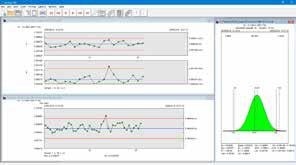
Statistical Process Control - Typical screen. Image Credit: Thermo Fisher Scientific - Elemental and Phase Analysis
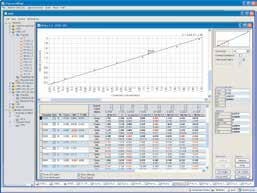
MVR calibration curve: real concentrations vs. intensities. Image Credit: Thermo Fisher Scientific - Elemental and Phase Analysis
Total Elemental Analysis
There are two alternatives for standard-less analytical programs:
- The QuantAS software scans up to 70 components from F to U with the F45 universal goniometer
- Semi-quantitative analysis can be completed within 3 minutes
- This program automates smoothing, background removal, peak identification, overlap and matrix corrections, semi-quantitative concentration computation, and normalization, making it simple to analyze unfamiliar compounds quickly
- UniQuant software can provide standard-free findings in 4-14 minutes, depending on the number of objects analyzed and time spent counting. It could be mounted on both the SmartGonio and the F45 universal goniometer. For applications requiring high precision and low concentration level detection, it is the preferable solution because of its longer counting time per element (2 to 20 seconds or more)
- Analyze up to 79 components without using particular standards. Perfect for collecting samples
- In small quantities
- In irregular shapes
- As monolayer coatings
- Identify remaining unanalyzed components in the sample, including organic and ultra-light components.
The QuantAS and UniQuant packages have been properly calibrated and deployed in the factory. Following commissioning, the instruments are instantly available for use. Stable samples for setup and long-term maintenance are available.
Turnkey Calibrations
Ex-works calibrations are offered for a range of materials, including:
- Clinker phases (C3S, C2S, C3A and C4AF)
- Iron ores according to ISO 9516
- Titanium alloys
- Tin and zinc low alloys
- Ferro-alloys and others for which analytical specifications are available on request
- Cement and clinkers
- Iron, steels and slags
- Copper, bronzes and brasses
- Aluminum and alloys
- Nickel, stellites and super-alloys
- Various oxides through the General Oxide calibration
- Traces in soils and sediments
Customer Support
The Backing of a Major International Corporation
The company helps customers all across the world.
- Application product teams might assist in developing specifications and suggest the ideal ARL 9900 for a particular application
- Committed training enables operators to use their ARL 9900 efficiently
- The ARL 9900 is durable and offers global aftersales support for common queries
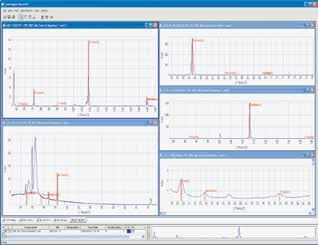
Example of QuantAS scans from which concentrations for the various elements in the sample are derived. Image Credit: Thermo Fisher Scientific - Elemental and Phase Analysis
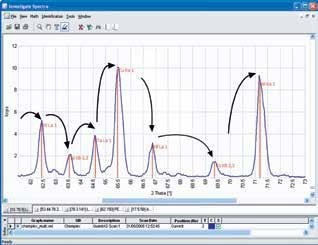
UniQuant uses "peak hopping" to acquire intensities for up to 122 line and background positions. Image Credit: Thermo Fisher Scientific - Elemental and Phase Analysis
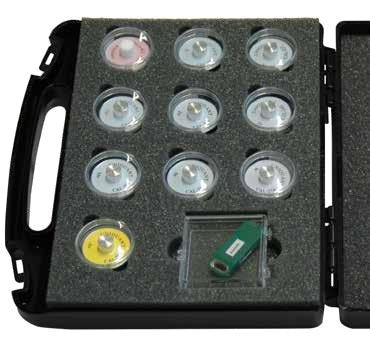
Image Credit: Thermo Fisher Scientific - Elemental and Phase Analysis
General Specifications for ARL 9900 Intellipower
Elemental Range
On a universal goniometer, boron (Nr. 5) to americium (Nr. 95), as long as all essential crystals are installed. SmartGonio: Oxygen (Nr. 8) to Amerium (Nr. 95)
Spectrometer Environment
Stabilized vacuum employing molecular pump.
Spectrometer Design
Analysis instruments are contained in a temperature-controlled grey cast iron vacuum chamber. A system of differential heating and cooling achieves temperature control. The crystals were maintained at a temperature of ±0.1°C.
Spectrometer Arrangement
The X-Ray tube is positioned vertically, 90° above the sample surface. Analytical equipment is positioned on a 360°ring, looking down at the sample surface.
X-Ray Tube
The latest generation of high-performance Rh anode end window tubes. The tiny Be window (0.05 mm) improves sensitivity to light components. LoVap technology provides outstanding long-term stability. Optional W and Mo anodes.
Monochromators
Fixed mechanical systems employ curved crystal optics (flat for light elements) and flow-proportional, sealed, or scintillation detectors. The monochromators have a temperature control range of ±0.1 °C. Absorbing filters can be used in extremely large quantities. Dual pulse height integration detects and corrects for second-order peaks.
Universal Goniometer
An optical encoder-equipped, gearless, microprocessor-powered goniometer. Up to 9 flat crystals can be fully configured automatically.
- Up to 9 flat crystals
- Up to 4 primary collimators: fine, medium, coarse, extra-coarse
- 2 detectors: scintillation and flow proportional (Ar/CH4 10 %: ultra-low flow 3 ml/min)
- Independent rotation of crystals and detectors
- Maximum slewing speed: 4800° 2θ/min
- Accuracy of peak positions vs. ASTM table on LiF crystals: 0.015°
- Angular reproducibility < ± 0.0002°
- Angular resolution 0.001°
- Total angle range: 0°-153° 2θ (Flow proportional counter: 17°-153°. Scintillation counter: 0°-115°)
- Continuous digital scans: from 0.25°/min to 1200°/min as function of measuring time and increment
- Step scan range: Minimum step: 0.001°
- Maximum practical: 1.00°
- Time of measurement for each step:0.1 s. - 655 s
SmartGonio
A microprocessor controls a gearless small goniometer and uses optical encoders. Completely autonomous programming of:
- 3 flat crystals
- 2 detectors: scintillation and flow proportional (Ar/CH4 10 %: ultra-low flow 3 ml/min)
- Fixed collimator selected according to customer’s application
- Independent rotation of crystals and detectors
- Maximum slewing speed: 5500° 2θ/min
- Accuracy of peak positions vs. ASTM table on LiF crystals: 0.015°
- Angular reproducibility: < ± 0.0002°
- Angular resolution: 0.001°
- Total angle range: 0°-150° 2θ (Flow proportional counter: 17°-150°. Scintillation counter: 0°-90°)
- Continuous digital scans: from 0.25°/min to 1200°/min as function of measuring time and increment
- Step scan range: Minimum step: 0.001°
- Maximum practical: 1.00°
- Time of measurement for each step: 0.1 s. - 655 s
Free Lime-Quartz-Limestone Channel
Small X-ray diffraction equipment with microprocessor control for quartz in raw meals, hot meal calcination tracking, limestone addition to cement, and free lime detection in clinker and slags.
Compact XRD System
Compact X-ray diffraction device with microprocessor control to track various functions and determine phase composition.
Counting Electronics
- Multichannel analyzer for better peak discrimination
- Digital Automatic Gain Control (AGC) counteracts the effects of pulse shrinkage. Automated dead time correction ensures linearity of response up to two Mcps on flow proportional counters, 1.5 Mcps on scintillation counters, and 1 Mcps on sealed detectors
Sample Changer and Cassettes
Basic magazine: 12 cassettes for samples of max. height 40 mm and diameter 60 mm.
Large capacity X-Y changer: 98 cassettes for samples of max. height 30 mm and diameter 52 mm or 98 samples on supports for direct introduction. Exposed opening 29 mm diameter (basic). Rotation of cassettes in analysis position: 60 rpm. Large changer is easily retrofittable.
Primary Beam Filter
Up to four settings are available for programming the main beam filter for X-Ray excitation.
- Cu: For analysis of Ru, Rh, Pd, Ag and Cd (elements that are interfered by Rh lines from the X-Ray tube) in light and variable matrices
- Al: To improve peak-to-background ratio on Pb or As in light matrices
- Other filters on request
Laboratory Information
- Internet connection
- Electrical safety: IEC 61010 – 1
- Radiation safety: fully protected system-interlock system complying with ISO 13489-1
- Electromagnetic compatibility: EN 61326-1 (group 1, class a, industrial)
Particular Specifications for ARL 9900 IntelliPower 1500
Spectrometer Capacity
- 12 fixed channels or
- 1 goniometer + 8 fixed channels or
- 1 goniometer + 1 compact XRD system + 8 fixed channels
X-Ray generator for 1500 W
- Solid state 1.5 kW high-frequency generator of maximum voltage 60 kV and maximum current 70 mA
- All kV/mA combinations must be chosen to be less than 1500 W.
- Maximum line voltage variation -15 % to +10 %. Stability ± 0.0001 % per 1 % variation
Power Requirements
- 3.8 kVA single phase for 1500 W
Cooling System
- Closed circuit for deionized water flowing via a heat exchanger that combines liquid and air
- Flow adjusted based on generator setting, between 0.5 and 5 lt/min (to maintain X-Ray tube temperature consistent)
Dimensions and weight for 1500 W
- H 166 cm, D 136.5 cm, W 93 cm with basic sample changer + H 47 cm, L 83.5 cm, W 41 cm. Weight: 785 kg
Particular Specifications for ARL 9900 IntelliPower 2500
Spectrometer Capacity
- 12 fixed channels or
- 1 goniometer + 8 fixed channels or
- 1 goniometer + 1 compact XRD system + 8 fixed channels
X-Ray Generator for 2500W
- Solid state 2.5 kW high-frequency generator of maximum voltage 60 kV and maximum current 100 mA
- All kV/mA combinations must be chosen to be less than 2500 W
- Maximum line voltage variation -15 % to +10 %. Stability ± 0.0001 % per 1 % variation
Power Requirements
- 5 kVA single phase for 2500 W
Cooling System
- Closed circuit for deionized water flowing through liquid/air heat exchanger
- Flow regulated between 0.5 and 5 lt/min according to generator setting (to keep X-Ray tube temperature constant)
Dimensions and weight for 2500 W
- H 166 cm, D 136.5 cm, W 93 cm with basic sample changer + H 47 cm, L 83.5 cm, W 41 cm. Weight: 785 kg
Particular Specifications for ARL 9900 IntelliPower 4200
Spectrometer Capacity
- 32 fixed channels or
- 1 goniometer + 24 fixed channels or
- 1 goniometer + 1 compact XRD system + 14 fixed channels
- Up to three goniometers configurations also available
X-Ray generator for 4200 W
- Solid state 4.2 kW high frequency generator (max. settings: 60 kV-70 mA or
- 35 kV-120 mA)
- All combinations must be chosen to be less than 4200 W
- Maximum line voltage variation -15 % to +10 %
- Stability ± 0.0001 % per 1 % variation
Power Requirements
- 7 kVA single phase for 4200 W
Cooling System
- Built-in closed circuit for deionized water flowing through liquid/liquid heat exchanger
- External water needed is <18°C, pressure≥ 2 bar, flow is regulated between 0.5 and 4.5 lt/min according to generator setting (water consumption minimization)
Dimensions and weight for 4200 W
- H 166 cm, D 136.5 cm, W 93 cm with basic sample changer. Weight: 750 kg